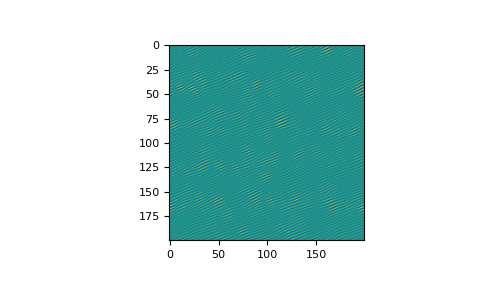numpy.fft.ifftn¶
- fft.ifftn(a, s=None, axes=None, norm=None)[source]¶
Compute the N-dimensional inverse discrete Fourier Transform.
This function computes the inverse of the N-dimensional discrete Fourier Transform over any number of axes in an M-dimensional array by means of the Fast Fourier Transform (FFT). In other words,
ifftn(fftn(a)) == ato within numerical accuracy. For a description of the definitions and conventions used, seenumpy.fft.The input, analogously to
ifft, should be ordered in the same way as is returned byfftn, i.e. it should have the term for zero frequency in all axes in the low-order corner, the positive frequency terms in the first half of all axes, the term for the Nyquist frequency in the middle of all axes and the negative frequency terms in the second half of all axes, in order of decreasingly negative frequency.- Parameters
- aarray_like
Input array, can be complex.
- ssequence of ints, optional
Shape (length of each transformed axis) of the output (
s[0]refers to axis 0,s[1]to axis 1, etc.). This corresponds tonforifft(x, n). Along any axis, if the given shape is smaller than that of the input, the input is cropped. If it is larger, the input is padded with zeros. if s is not given, the shape of the input along the axes specified by axes is used. See notes for issue onifftzero padding.- axessequence of ints, optional
Axes over which to compute the IFFT. If not given, the last
len(s)axes are used, or all axes if s is also not specified. Repeated indices in axes means that the inverse transform over that axis is performed multiple times.- norm{“backward”, “ortho”, “forward”}, optional
New in version 1.10.0.
Normalization mode (see
numpy.fft). Default is “backward”. Indicates which direction of the forward/backward pair of transforms is scaled and with what normalization factor.New in version 1.20.0: The “backward”, “forward” values were added.
- Returns
- outcomplex ndarray
The truncated or zero-padded input, transformed along the axes indicated by axes, or by a combination of s or a, as explained in the parameters section above.
- Raises
- ValueError
If s and axes have different length.
- IndexError
If an element of axes is larger than than the number of axes of a.
See also
numpy.fftOverall view of discrete Fourier transforms, with definitions and conventions used.
fftnThe forward n-dimensional FFT, of which
ifftnis the inverse.ifftThe one-dimensional inverse FFT.
ifft2The two-dimensional inverse FFT.
ifftshiftUndoes
fftshift, shifts zero-frequency terms to beginning of array.
Notes
See
numpy.fftfor definitions and conventions used.Zero-padding, analogously with
ifft, is performed by appending zeros to the input along the specified dimension. Although this is the common approach, it might lead to surprising results. If another form of zero padding is desired, it must be performed beforeifftnis called.Examples
>>> a = np.eye(4) >>> np.fft.ifftn(np.fft.fftn(a, axes=(0,)), axes=(1,)) array([[1.+0.j, 0.+0.j, 0.+0.j, 0.+0.j], # may vary [0.+0.j, 1.+0.j, 0.+0.j, 0.+0.j], [0.+0.j, 0.+0.j, 1.+0.j, 0.+0.j], [0.+0.j, 0.+0.j, 0.+0.j, 1.+0.j]])
Create and plot an image with band-limited frequency content:
>>> import matplotlib.pyplot as plt >>> n = np.zeros((200,200), dtype=complex) >>> n[60:80, 20:40] = np.exp(1j*np.random.uniform(0, 2*np.pi, (20, 20))) >>> im = np.fft.ifftn(n).real >>> plt.imshow(im) <matplotlib.image.AxesImage object at 0x...> >>> plt.show()
